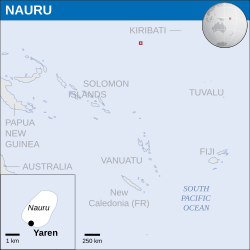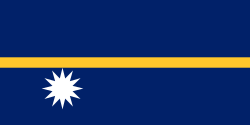Nauru

Nauru is a nominally independent island in the Pacific Ocean that once enjoyed a very high standard of living owing to its minuscule population (today less than 11,000) and huge riches of phosphate (aka high-quality bird poop). These days the interior is entirely desolate as phosphate supplies have largely been exhausted, the government is highly unstable and practically bankrupt, and Australia calls most of the shots. The population suffers some of the very highest rates of obesity and diabetes in the world and does not have the facilities to deal with these issues. All residents live on the coast, which is also at risk due to rising sea levels caused by global warming.
The future is very much in doubt, and Nauru serves as a cautionary tale to other societies based on a mirage of endless prosperity.
How it went down[edit]
Historically an isolated, indigenous Polynesian island, Nauru was first contacted by Europeans when John Fearne made landing in 1798. Following the charting of a route to Nauru, the Nauruans regularly traded with Western merchants and whalers.[2] In turn, Europeans began living there as well and making Nauru out to be a lucrative good; so good, in fact, that there was a 10-year civil war (1878 to 1888), at the end of which Nauru was annexed to Germany's Marshall Islands.[3]
It was around this time (1900) that phosphate was first discovered on the island. Exports were initially controlled by Germany. Following the first World War, Nauru was given to Australia as part of the agreements of the League of Nations.[3] Australia more or less ruled over the nation until 1968, when Nauru became fully independent. The Nauru Phosphate Corporation (NPC, later RONPhos) was founded shortly afterward in 1970.
With no other nations looking over its shoulder, Nauru was free to ship phosphate wherever the hell it pleased. Income per capita shot up during the 1970s to around USD$50,000, rivaling only Saudi Arabia at that time.[4] Massive income and no tax rate made Nauru a hotspot for rich entrepreneurs and tax-allergic businessmen. However, prosperity did not last very long, as by the late 1980s phosphate resources were declining rapidly. The country began to export other goods in addition to smaller-scale mining, which led to losses in export income. By 2010 much of the phosphate was depleted. The country now sells fishing rights to other Oceanic countries for income.
Economic state of Nauru[edit]
The decrease in Nauru's GDP is truly staggering: USD$50,000 in 1975 to US$2,400 in 2007.[5] There's a good chance this value is even lower, since statistics are hard to find. Numbers from 2011 put unemployment at around 23%[6], down from almost 90% in 2004.[7] Due to the nation's tax-exempt status, which was established in the mid-1990s, the government makes very little money off of citizens. The primary sources of income for the island are the aforementioned fishing rights sales and revenue from the Nauru Detention Center; the Center's closing from 2007 to 2012 caused a moderate recession.[8] Nauru now relies on around US$20 million in foreign aid per year from Australia.
Payment from citizens is cash-only, as both of the island's banks[note 1] were bankrupt by 2004, and leases for offshore banks were halted to prevent money laundering and offshore transfers. Income tax was not reestablished until 2014, with a flat rate of 10%; considering current GDP, this is still basically nothing.
Life on Nauru[edit]
The rates of obesity and type 2 diabetes on Nauru are the highest in the world: 71% of citizens are overweight or obese, and diabetes is extremely common.[9] Tourism is low, with flights only going five days per week, and is limited by the small number of planes owned by the country. The island has pretty much no attractions, and around 80% part of the island is just the desecrated, barren remains of the phosphate mines.
The island is also under threat by global warming. While Nauru probably won't submerge under the sea like the Kiribati, it might as well be. The sea level rise could contaminate their groundwater supply and only freshwater lagoon with saltwater, and since most of the population and infrastructure, including its only airport and hospital, is situated on/near the shore,[10] the country is very vulnerable to coastal flooding. Nauru's sea level rise is predicted to be 2-3 times the projected global average.[11] Moreover, 61% of its households have been impacted by droughts or irregular rains, a troubling prospect given much of the country relies on rainwater collection for drinking water.[12] In response, the island's government is attempting to relocate the populace to the island's "Topside", its mined-out but higher elevation interior, among other measures.[10]
Nauru's only sewage treatment plant is located in a primary school, and most of its residents rely on septic tanks and cesspits, many of which are leaking into the soil. The country's growing importation of disposable consumer goods is straining the island's waste management system, and the leachate from its landfill could contaminate Nauru's groundwater reservoir. Nauru is also still trying to remove all the asbestos off the island, much of which has been improperly removed and stored, potentially putting many at risk of mesothelioma and other diseases, and, again, polluting the groundwater.[13][14][10]
In short, Nauru contains a lesson about the exploitation of resources, and the consequences of going too big, too fast, and not being able to sustain your growth rate. Does that sound familiar? In any case, Nauru is a textbook cautionary tale, a story of greed unchecked and a masterclass in poor government and economic management.
Gallery[edit]
A pizza shop in Aiwo, a Pizza Hut
 if you will.
if you will.
Notes[edit]
- ↑ the Bank of Nauru and the Republic of Nauru Finance Corporation
References[edit]
- ↑ 1.0 1.1 "Report for Selected Countries and Subjects".
- ↑ Maslyn Williams & Barrie Macdonald (1985). The Phosphateers. Melbourne University Press. p. 11. ISBN 0-522-84302-6.
- ↑ 3.0 3.1 "Commonwealth and Colonial Law" by Kenneth Roberts-Wray, London, Stevens, 1966. p. 884.
- ↑ "From economic haven to refugee 'hell'", Kyodo News.
- ↑ "Country Economic Report: Nauru", Asian Development Bank.
- ↑ "Paradise well and truly lost", The Economist.
- ↑ "Nauru", CIA World Factbook.
- ↑ "Nauru 'hit' by detention centre closure", The Age.
- ↑ "Nauru: An island plagued by obesity and diabetes", Asahi Shimbun.
- ↑ 10.0 10.1 10.2 Republic of Nauru. (n.d.) Updated Nationally Determined Contribution.
- ↑ Mulhern, O. (2020, August 6). Sea Level Rise Projection Map – Nauru. Earth.Org.
- ↑ Campbell, J., Oakes, R., and Milan, A. (2016). Nauru: Climate change and migration – Relationships between household vulnerability, human mobility and climate change. Report No.19. Bonn: United Nations University Institute for Environment and Human Security (UNU-EHS).
- ↑ Dziedzic, S. (2019, March 18). Nauru refugees exposed to asbestos after shipping containers dumped just metres away. Australian Broadcasting Corporation.
- ↑ Walsh, M. (2015, November 29). Safety concerns for refugees and workers as Nauru asbestos removal program kicks off. Australian Broadcasting Corporation.







